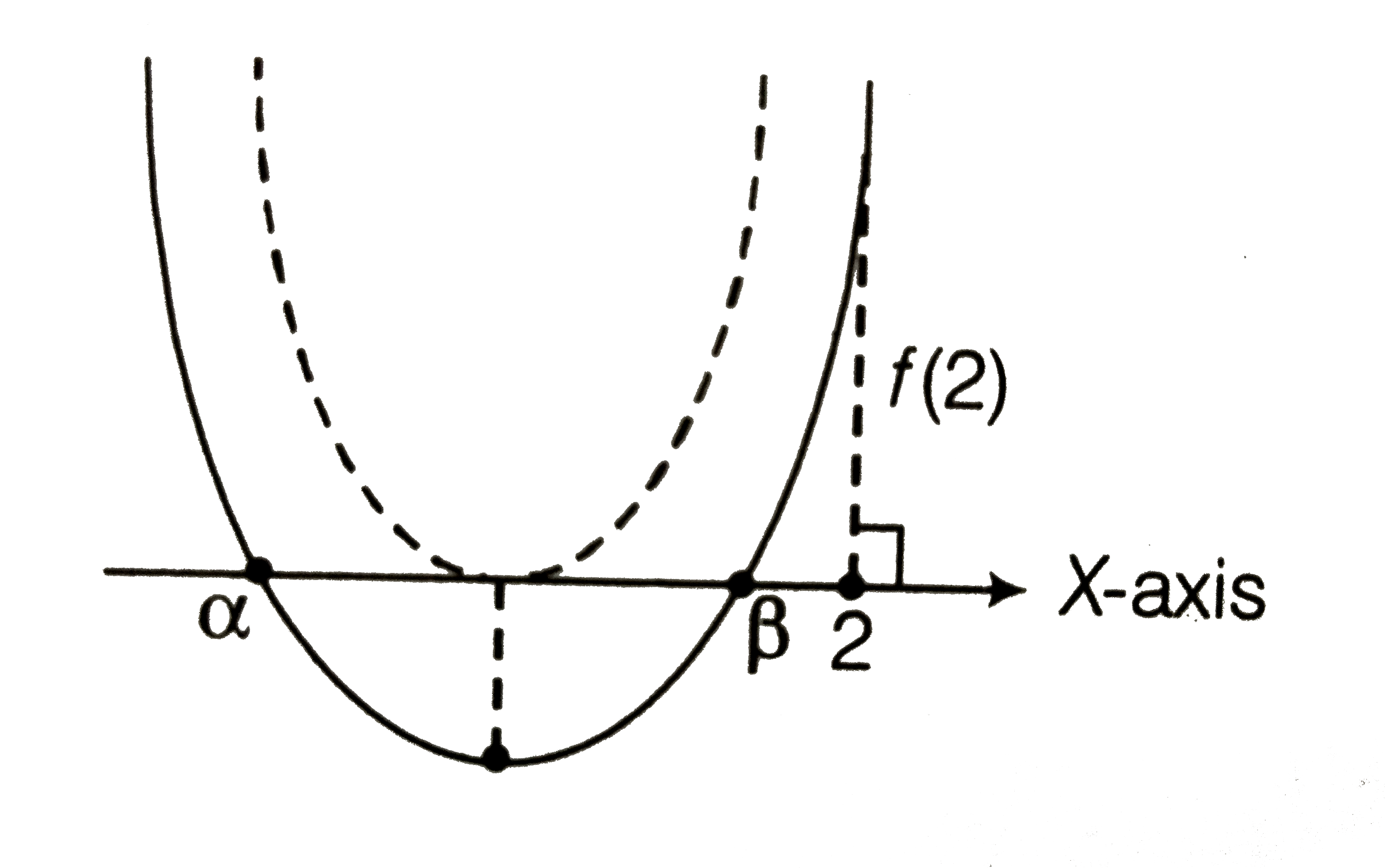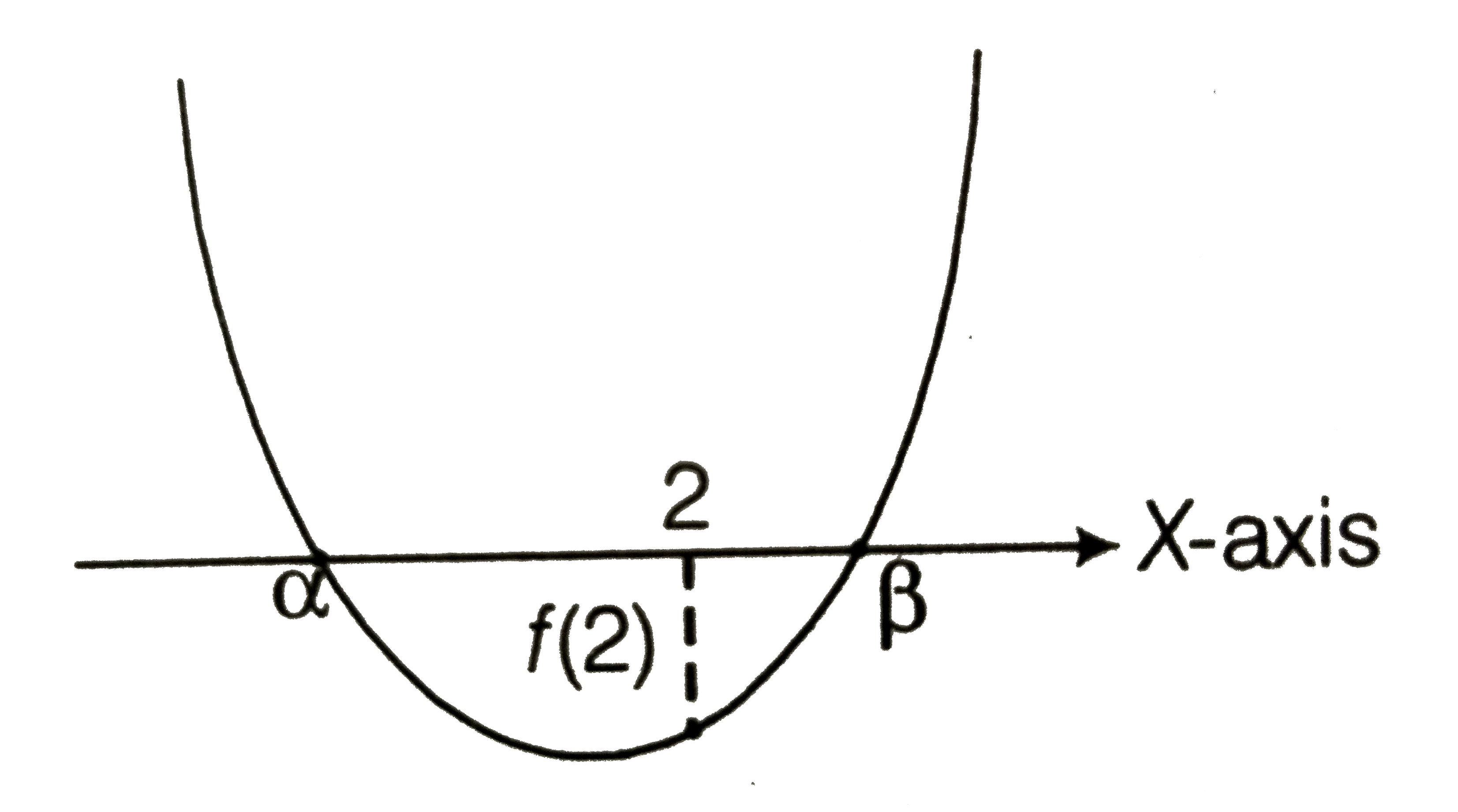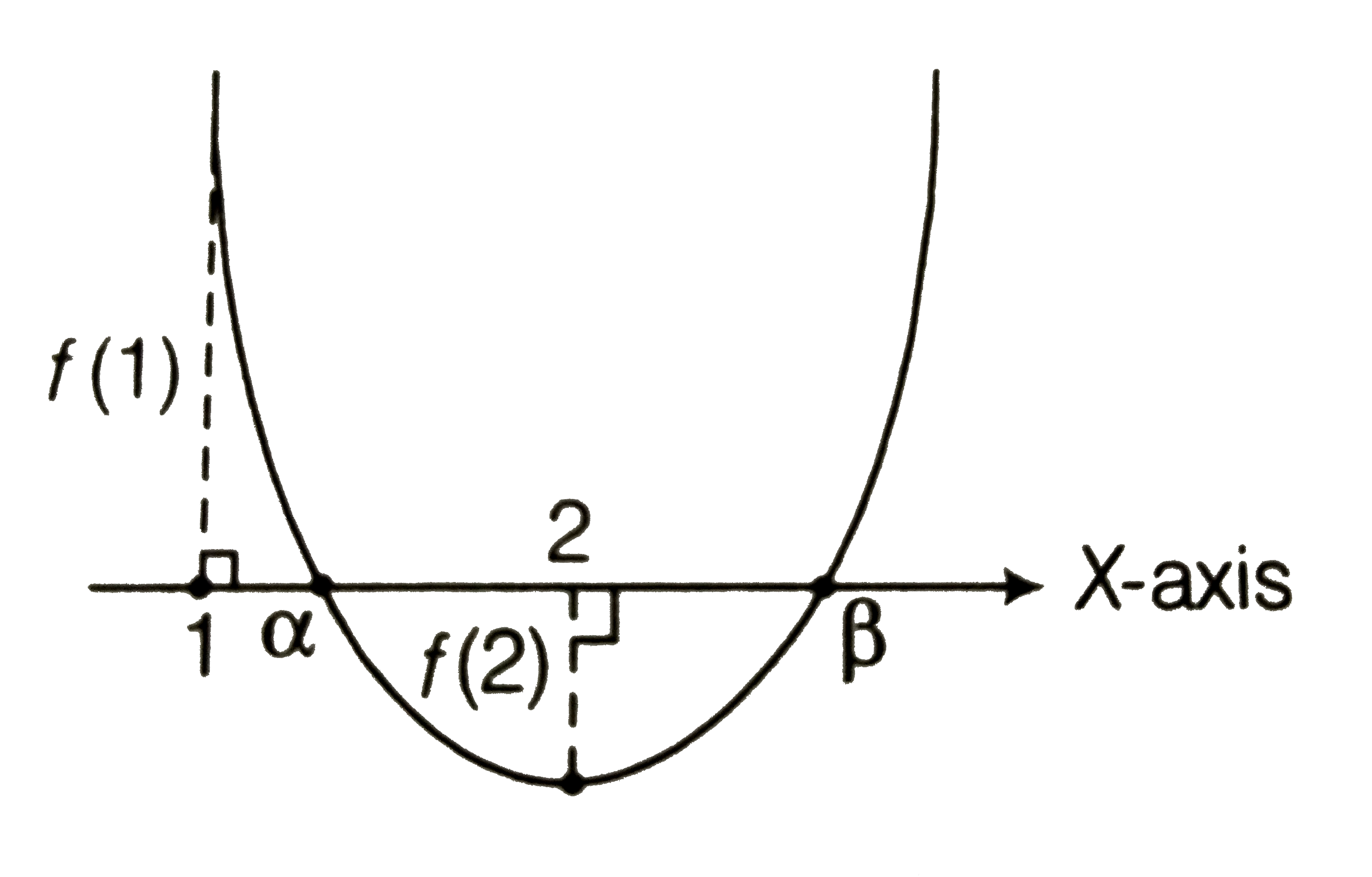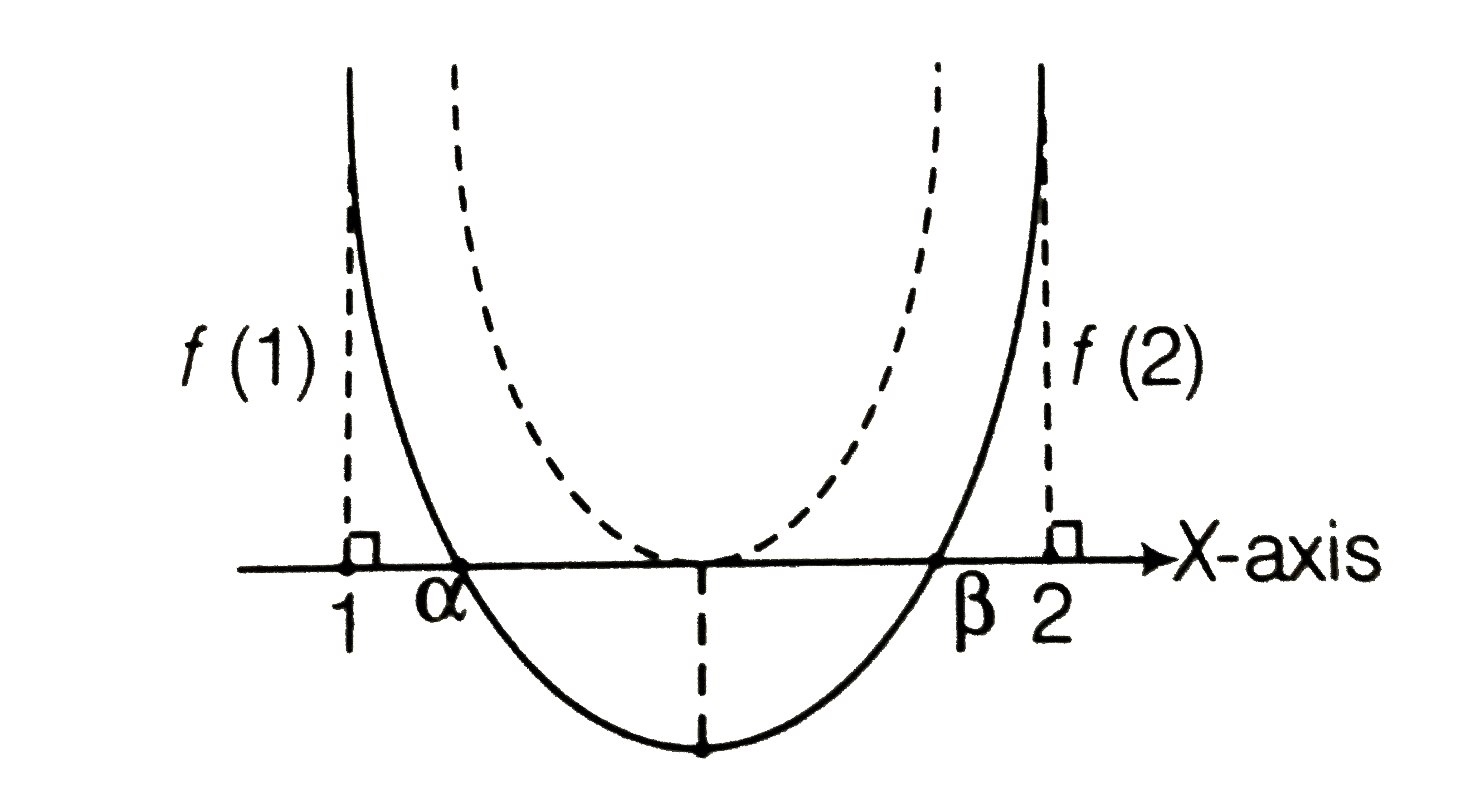Let x2−(m−3)x+m=0(mεR) be a quadratic equation . Find the values of m for which the roots are (ix)one root is smaller than 2 & other root is greater than 2 (x) both the roots are greater than 2 (xi) both the roots are smaller than 2 (xii)exactly one root lies in the interval (1;2) (xiii) both the roots lies in the interval (1;2) (xiv) atleast one root lies in the interval (1;2) (xv) one root is greater than 2 and the other root is smaller than 1
Let f(x)=x2−(m−3)x+m
Here a=1,b=−(m−3),c=m
and D=b2−4ac=(m−3)2−4m
=m2−10m+9=(m−1)(m−9)
and x-x coordinate of vertex =−b2a=(m−3)2
(i) Both the roots are smaller than 2 D≥0

i.e. (m−1)(m−9)≥0
∴mε(−∞1[∪[9,∞) ............i
f(2)>0
i.e. 4−2(m−3)+m≥0
⇒m<10
∴mε(−∞,10)......ii and x- coordinate of vertex <2
i.e. (m−3)2<⇒m<7
∴mε(−∞,7) iii
On combining Eqs.i,ii, and iii we get
mε(−∞,1]
(ii) Both the roots are greater than 2 D≥0

i.e. (m−1)(m−9)≥0
∴mε(−∞,1]ε[9,∞).........i
f(2)>0
i.e. 4−2(m−3)+m>0
⇒m<10......ii
and x-coordinate of vertex >2
i.e. (m−3)2>⇒m<7
∴mε(7,∞) .....iii
On combining Eqs. i, ii and iii we get
mε[9,10)
(iii) One root is smaller than 2 and the other root is greater than 2
D<0

i.e. (m−1)(m−9)>0
∴mε(−∞,1)∪(9,∞)....i
f(2)<0
i.e 4−2(m−3)+m<0
∴m>10
∴mε(10,∞)....ii
On combining Eqs i and ii we get
mε(10,∞)
(iv) Exactly one root lies in the interval (1,2)
D>0

i.e., (m−1)(m−9)>0
∴mε(−∞,1)∪(9,∞)...i
f(1)f(2)<0
(1−(m−3)+m)(4−2(m−3)+m)<0
⇒4(−m+10)<0
⇒m−10>0⇒m>10
∴mε(10,∞) ....ii
On combining Eqs (i) and (ii) we get
mε(10,∞)
(v) Both the roots lie in the interval (1,2)
D≥0

i.e. (m−1)(m−9)≥0
∴mε(−∞,1]∪[9,∞)...i
f(1)>0
i.e. (1−(m−3)+m)>0⇒4>0
∴mεR.ii
f(2)>0
i.e. 4−2(m−3)+m>0⇒m<10
∴mε(−∞,10)..iii
1<x coordinate of vertex <2
i.e. 1<(m−3)2<2
⇒2<m−3<4 or 5<m<7
∴mε(5,7).iv
On combining Eqs. i,ii,iii and iv we get
mεϕ
(vi) One root is greater than 2 and the other root is smaller than 1D>0

i.e. (m−1)(m−9)>0
∴mε(−∞,1)∪(9,∞).i
f(1)<0
i.e. 4<0 which is not possible.
Thus , no such m exists.
(vii) At least one root lie in the interval (1,2)
Case I Exactly one root lies in (1,2)
mε(10,∞) [from (iv) part]
Case II Both roots lie in the interval (1,2).
mε(10,∞)
(viii) Atleast one root is greater than 2
Case I One root is smaller than 2 and the other root is greater than 2.
Then, mε(10,∞) [from iii) part]
Case II Both the roots are greaters than 2 then mε[9,10).
Hence atleast one root is greater than 2.
∴mε(10,∞)∪[9,10) or mε[9,10)∪(10,∞)
Topper's Solved these Questions
- BOOK - ARIHANT MATHSCHAPTER - THEORY OF EQUATIONSEXERCISE - Exercise For Session 111videos
THEORY OF EQUATIONS
- BOOK - ARIHANT MATHSCHAPTER - THEORY OF EQUATIONSEXERCISE - Exercise For Session 210videos
THEORY OF EQUATIONS
- BOOK - ARIHANT MATHSCHAPTER - THE STRAIGHT LINESEXERCISE - Exercise (Questions Asked In Previous 13 Years Exam)18videos
THE STRAIGHT LINES
- BOOK - ARIHANT MATHSCHAPTER - THREE DIMENSIONAL COORDINATE SYSTEMEXERCISE - Exercise (Questions Asked In Previous 13 Years Exam)44videos
THREE DIMENSIONAL COORDINATE SYSTEM
Similar Questions
Let x2−(m−3)x+m=0(m∈ R) be a quadratic equation. Find the value of m for which the roots are
(i) real and distinct
(ii) equal
(iii) not real
(iv) oppsite in sing
(v) equal in magnitude but opposite in sing
(vi) positive
(vii) negative
(viii) such that at least one is positive
(ix) one root is smaller than 2 and the other root is greater then 2
(x) both the roots are grater then 2
(xi) both the roots are smaller then 2
(xii) exactly one root lies in the interval ( 1, 2)
(xiii) both the roots lie in the interval (1, 2)
(xvi) at least one root lies in the interval (1, 2)
(xv) one root is greater than 2 and the other root is smaller than 1View SolutionLet 4x2−4(α−2)x+α−2=0(α∈R) be a quadratic equation. Find the values of α for which
One root is smaller than 12 and other root is greater than 12View Solution
Knowledge Check
- Question 1 - Select One
If one root is greater then 3 and other root is less than 1 'a' belongs to
AϕB(−1,2)∪(2,3)C(−∞,2)D(2,∞)
Let 4x2−4(α−2)x+α−2=0(α∈R) be a quadratic equation. Find the values of α for which
Both the roots are smaller than 12View SolutionLet 4x2−4(α−2)x+α−2=0(α∈R) be a quadratic equation. Find the values of α for which
One root is greater than 12 and other is smaller than 0View SolutionLet 4x2−4(α−2)x+α−2=0(α∈R) be a quadratic equation. Find the values of α for which
Both the roots are greater than 12View SolutionLet x2−2(a−1)x+a−1=0(a∈R) be a quadratic equation, then find the value of 'a' for which
(a) Both the roots are positive
(b)Both the roots are negative
(c) Both the roots are opposite in sign.
(d) Both the roots are greater than 1.
(e)Both the roots are smaller than 1.
(f) One root is small than 1 and the other root is greater than 1.View SolutionFind the values of a for which one root of equation (a−5)x2−2ax+a−4=0 is smaller than 1 and the other greater than 2.
View SolutionDifferent condition for location of roots(vi) If α<k<β (vii)Exactly one root lying in the interval (k1,k2) (viii) Both the roots lying in the interval (k1,k2) (ix)One root is smaller than k1 and other roots is greater than k2
View SolutionLet x2−2(a−1)x+a−1=0(a∈R) be a quadratic equation, then find the values of "a" for which
(i) Exactly one root lies in (0,1)View Solution
